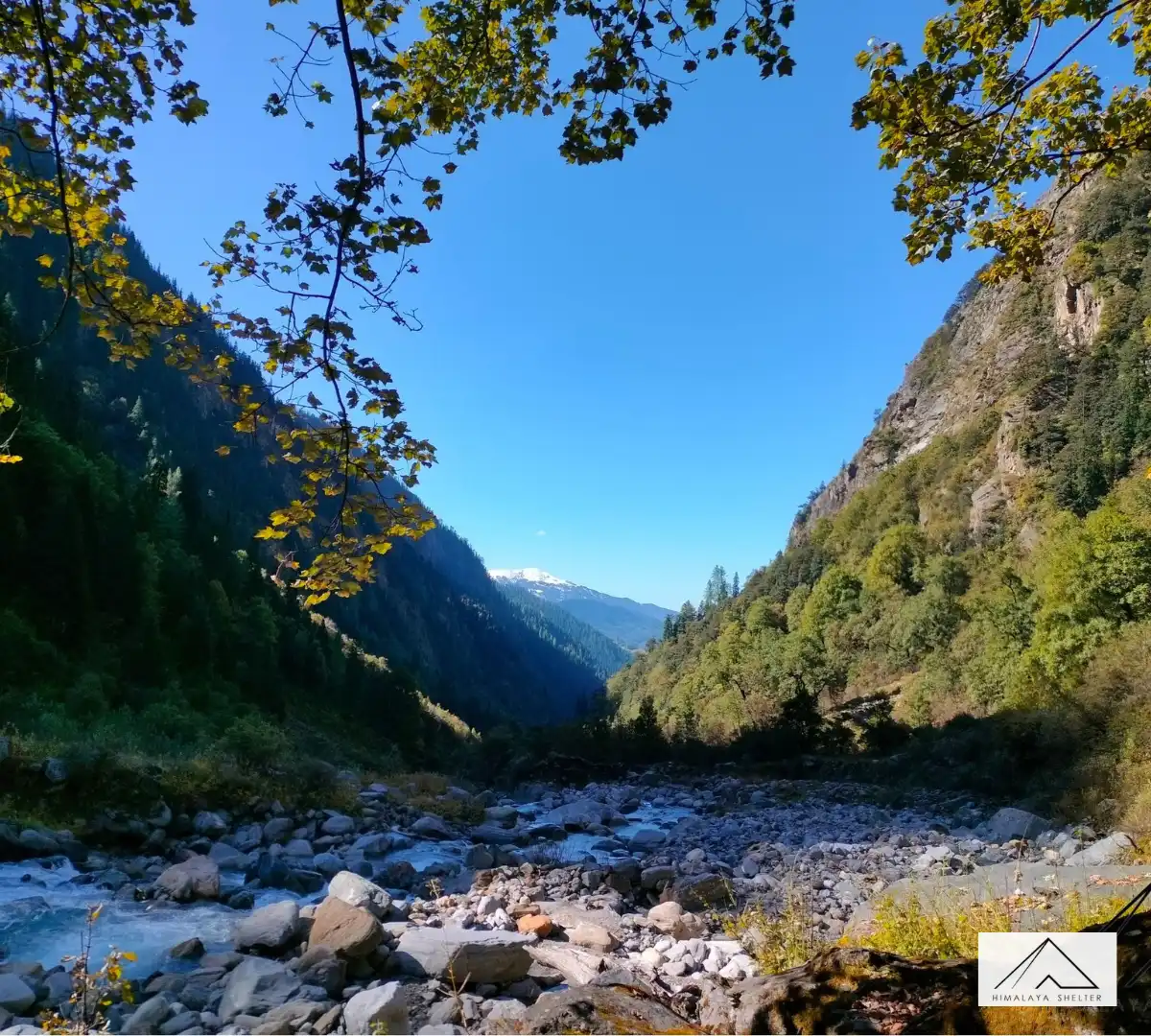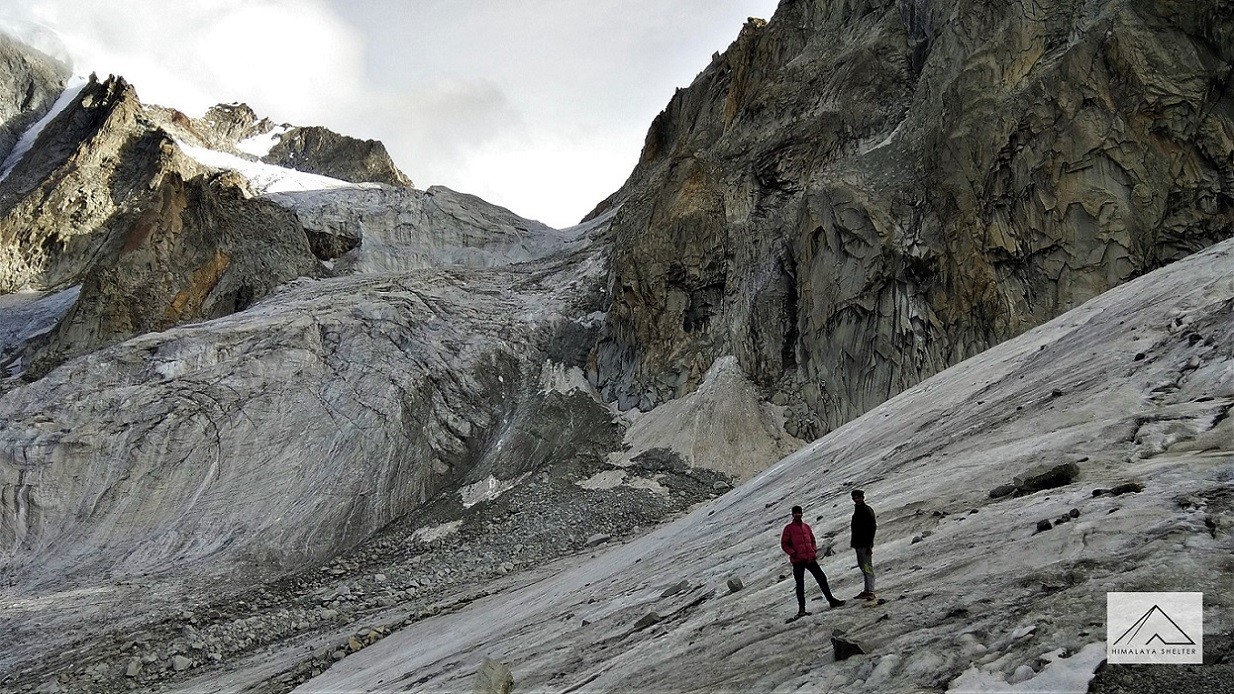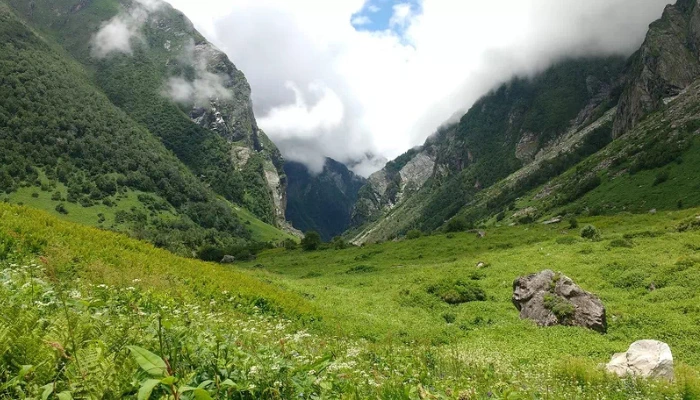
Dev Kyara Trek
TREK DIFFICULTY
Easy - Moderate
TREK DURATION
7 Days
HIGHEST ALTITUDE
13,450 Feet
GROUP SIZE
12
TREK DISTANCE
38 Km
BASECAMP
Uttarakhand
BEST TIME
May to June | September to October
PICKUP POINT
Dehradun (Prince Chowk)
Dev Kyara Trek Overview
Dev Kyara Trek, This valley was first mentioned by Harish Kapadia in his travel books, after he explored the untouched regions of western Garhwal. Even today this narrow valley is hardly frequented by trekkers; although the locals do visit on religious occasions. The Obra gad (a river stream) is a tributary of the Supin River, and starts below the Ranglana peak before merging with the Supin River below Jakhol village. The obra gad valley is beautiful with the very scarcely attempted Ranglana peak (6000m +) at its head and the noisy Obra gad flowing endlessly. As we progress into the valley, its flowers and biodiversity is visible. The cherries growing abundantly are a feast for the merry trekkers.

The highest point in the trek is the Dev Kyara Bugyal (meadow) which is worshiped by the locals. This campsite is the highlight of the trek and it’s very rewarding to camp here an extra night. One can also cross the pass on the ridge on the left bank of Obra and enter into the beautiful Har Ki Dun valley. However, the trek will be longer in duration.
The Dev Kyara Glacier is the origin of many Himalayan rivers. Your trek to Dev Kyara starts from Sankri. The route is very stunning and has serene views. You can enjoy every moment on the route to Dev Kyara. The big meadows filled with wildflowers give the feeling of fullness. All the campsites on the Dev Kyara trek are beautiful. You will camp near the river and can enjoy the calmness. It is a remote trek, and all you can hear is the sound of birds and rivers. The Dev Kyara is near the Har ki dun trek. But the Har Ki Dun trek is very popular and usually crowded in peak seasons. The Dev Kyara trek is very similar to the Har Ki Dun trek, but is still less well-known. This trek holds both beauty and spiritual value.
History Of Dev Kyara Trek
The Dev Kyara Trek is nature's admiration. This beautiful valley holds deep connections with history and culture. Dev Kyara Trek is not a commercialized trek and still unknown to many people. But the locals believe in the divisiveness of the valley. Some say that Dev Kyara Valley was the resting ground for the Panavas during their exile. The name “ Dev Kyara” means “ Field or Pasture of God”. This beautiful valley is also home to many local deities like the Ranglana Devta. The locals of nearby villages offer prayers.
The Dev Kyara Trek is not a mainstream trekking route, but it has been serving as a grazing meadow for centuries. The locals still take their cattle to the big alpine meadows of Dev Kyara in the summer. The value of Dev Kyara Valley for the locals is something different. You can feel the zeal of locals while trekking to the Dev Kyara Valley. This trek is gaining the attention of the people who seek peace. Trekkers love the Dev Kyara trek due to the less crowd and alluring landscapes.
Highlights Of Dev Kyara Trek
Vast Alpine Meadow
The Dev Kyara Trek leads you to a big alpine meadow. This might be one of the biggest alpine meadows in the country. Unlike small alpine meadows, the Dev Kyara Valley is vast and mesmerizing. All you can see is a big green meadow between huge mountains. You can also see different varieties of wildflowers in the summer. Autumn is somewhat different as the whole meadow becomes golden and looks majestic in the daytime.
Diverse Landscape
The scenery of the Dev Kyara Trek is inimitable. You won’t find the charm of the Dev Kyara Trek in any other treks. The trek starts from Sankri, which is itself a beautiful village. When you walk further, you enter the big forests. The big pine, oak, and rhodo trees open the trail for you. Small streams and old wooden bridges in the trek enhance the beauty of the trek.
Remoteness and Trail Conditions
The Dev Kyara Trek is a remote trek, and not many people know about this valley. The trek is moderately difficult and has only a few tricky sections. You can complete the trek without facing big physical or mental challenges. The whole trail is appealing and divine.
Spiritual Significance
The name “ Dev Kyara” itself means "Field of God”. The Dev Kyara Valley has big mythological value among the locals. You will also see small temples in the valley. The locals often visit the valley on certain occasions. Some people believe that the Dev Kyara is also related to the Mahabharata.
Difficulty Level of Dev Kyara Trek
Dev Kyara is a moderate-level Himalayan trek. The trail is good, and the altitude is also manageable. You can also plan the Dev Kyara trek as a beginner. The trek has some challenging sections, which may increase the difficulty level.
-
Trail Condition
The trail to Dev Kyara Valley starts with the easy section. You will walk through the forests and marked routes. The trail becomes difficult when you ascend to higher regions. Some sections are very narrow and have loose rocks. You need to be careful while walking.
-
High-Altitude
The altitude of the Dev Kyara Valley is 4100 m. This is a moderate height for Himalayan treks. The AMS risk is low. But you may get a headache or nausea if you are dehydrated. You should hydrate enough and take a good rest at night.
-
Remoteness and Trek Duration
Dev Kyara Valley is a remote trek, and you won’t find any shops or resting zones once you leave the village. You will trek for about 40 km in a week. You have to walk for about 8 km daily. The lower sections are easy to cover. But trekking to higher altitude areas can be difficult.
-
Weather Condition
You cannot predict the weather in higher altitude areas. You should prepare yourself for any type of weather. Sunny days mean dry trails and clear views. But rain and snowfall can make your trail challenging. The trail became very muddy and slippery.
Best Time To Visit The Dev Kyara Trek
You can plan your Dev Kyara Trek in the summer. Another good time for planning your Dev Kyara Trek is autumn.
-
Dev Kyara Trek In May And June
Summer is the best time to plan your Dev Kyara Trek. You will see greenery all around you. The small streams and wooden bridges look very beautiful. The temperature and weather conditions are also pretty decent.
-
Dev Kyara Trek In July And August
Monsoon can make your trek a bit challenging. This area receives a high amount of rainfall, which can make the trails very difficult. You can also face problems in crossing the streams. In the monsoon, leeches are common in the forest areas. The fog will cover the views, and some areas may have very little visibility.
-
Dev Kyara Trek In September And October
Plan your Dev Kyara Trek post-monsoon to experience the golden autumn. The vast meadow will start turning golden, and the sunrise and sunset in the valley look majestic. The trail becomes dry, and you can trek without any difficulty.
-
Dev Kyara Trek From November To April
Winters in Dev Kyara Valley are not for beginners. The valley and trail are buried somewhere in the snow. Some areas don’t have access, and walking on heavy snow is difficult. Winter Dev Kyara Trek is only for seasoned trekkers.
How To Reach Dev Kyara Trek?
You will start your trek to Dev Kyara Trek from Sankri. This beautiful village is a basecamp for many famous treks. Reach Sankri a day before the trek and take a good rest. You can also roam around the village and talk to the locals.
Sankri Via Road
Sankri has good road connectivity from Dehradun. You can take a bus to Dehradun from Delhi or other cities. Now from Dehradun, you can find direct buses to Sankri. The distance is about 200 km and will take about 9 hours. You can also find some shared taxi options for Sankri.
Sankri Via Railways
You can look for the trains to Dehradun. You can find direct trains from Delhi, Mumbai, and some other major cities. Rishikesh also has good railway connectivity. Now reach Rishikesh and take a local bus to Dehradun. Look for buses or taxi services to Sankri.
Sankri Via Air
You can take a flight to Jolly Grant Airport(Dehradun). Many direct flights are available from major cities on a daily basis. Now you have to take a cab and reach the Dehradun bus stand. Take a direct bus to Sankri. You can also book a private taxi or take shared sumo services.
Day 1: Dehradun to Sankri
Day 2: Sankri to Obra Campsite
Day 3: Obra Thatch to Bhawa Waterfall Campsite
Day 4: Bhawa Waterfall Campsite to Dev Kyara Trek
Day 5: Dev Kyara explore & return to Bhawa Waterfall
Day 6: Bhawa Waterfall to Sankri via Jakhol
Day 7: Sankri to Dehradun
Checklist all the essential gear for the Dev Kyara trek. Good preparation means you can enjoy your whole trek without any worry.
Clothing And Backpack
Start looking for a good quality backpack (50L-60L). Your backpack must be waterproof and should provide good back support. You will also need a small backpack for the day hikes. Now start packing your clothes with a pair of thermals. Pack 3 quick-dry t-shirts and 2 pairs of trekking pants. Pack a fleece jacket and a down jacket. Carry a windcheater rain jacket. Now pack a sun cap and a woolen cap. Get 2 pairs of gloves (woolen and waterproof).
Footwear
Get a good pair of waterproof trekking shoes. Your feet must be familiar with your shoes. If you are buying a new pair, then wear it for about 10-15 days before starting the trek. Your shoes should also provide ankle support. Now pack 6 pairs of socks ( cotton and woolens). Pack a pair of sandals for the campsite areas.
Personal Care
Take a waterproof pouch and pack all your toiletries. Now pack a quick-dry towel and a toilet roll. Get a water bottle to keep you hydrated on the trek. Now pack sunscreen for daytime. Get a moisturiser for dry skin and lip balm for the chapped lips. You can also make a small medical kit with basic medicines. Carry your government ID with you.
In Himalaya Shelter, we provide you with the option to customize your trekking experience. Whether you're a solo traveler, a group of friends, or a family, you can opt for our personalized tailor-made trekking program. This customized trek will be exclusively designed for you, taking into account your specific requirements for transportation, accommodation, meals, and any other premium facilities you may need during the trek. No other participants will be added to your group. Choosing a customized trek will enable you to fully enjoy the trek with your loved ones.
Day 1: Dehradun to Sankri
Drive: 190 km, 8-9 hrs
Altitude: 2,100 ft (640 m) – 6,725 ft (2,049 m)
Accommodation: Himalaya Shelter Guest House
Meals: Dinner
We start the journey early from Dehradun and drive initially to the famous hill station of Mussoorie. After just over 100 km, we pass close to the temple of Lakhamandal. According to locals, Duryodhana of the epic Mahabharata conspired to burn the Lakshagriha house of the Pandavas in this area. Damta, Purola, Mori and Netwar are some of the other villages on the route. We follow the river Yamuna Naugaon and accompanies us till Purola. Purola is the last big settlement on the route with a large market. So, it is recommended that the trekkers can buy anything they might have missed out by Purola itself. It also is the last village where most of the mobile networks work.
The drive after Purola is through a beautiful forest of pine trees. In some distance, on top of a hill we can see the Jawahar Navodaya Vidyalaya overlooking the valley. From near the village of Mori, the river Netwar. The fall in temperature can be felt from here. We officially enter Govind Pashu Vihar Wildlife Sanctuary after we cross a check post at Netwar. It can be considered the southern gateway to the sanctuary as most of the treks across the region are accessed from here onwards. The northern border of the sanctuary merges into Himachal Pradesh. Close to here, the rivers of Rupin and Supin merge to form Tons, which is the largest tributary of Yamuna and in fact larger than Yamuna itself, in terms of volume of flow. The peak of Kedarkantha can be seen from various points along the way from here.
We reach Sankri by early evening. It is a small village with a central market lined with a few shops. The village has numerous apple orchards which are harvested starting from late summer. The market area is new compared to the old village area, a part of which is known as ‘Saud’. The village also produces peach, apricots and potatoes. One can see the Swargarohini peak from here on a clear day. We rest at night in a guest house or in camps.
Day 2: Sankri to Obra Campsite
Trek: 5 km, 4 hrs
Altitude: 6,725 ft (2,049 m) – 7,644 ft (2,330 m)
Accommodation: Camping (Alpine Tents)
Meals: Breakfast + Lunch + Evening Snacks + Dinner
We Start the day early as we head towards the Obra Thatch campsite with the trek being rather easy on this day. We follow the river with pleasant views and resting spots along the way. Reaching the campsite well in the afternoon hours we have plenty of time post the camp setup to rest, or hike around the campsite. On a good summer day it can be pleasing to find a spot along the stream for a quick dip into the river, as long as the sun shines overhead.On reaching Sikolta, set your bags down and take an excursion to Juda ka Talab, a well-known lake among the trekking community.
Day 3: Obra Thatch to Bhawa Waterfall Campsite
Trek: 8 km, 6 hrs
Altitude: 7,644 ft (2,330 m) – 11,220 ft (3,420 ft)
Accommodation: Camping (Alpine Tents)
Meals: Breakfast + Lunch + Evening Snacks + Dinner
The second trekking day is going to be the longest trekking day with significant altitude gain during the journey. After the initial ascend through the dense pine forest the landscape gradually transcends into a magnificent open valley with unparalleled views of huge snow-capped mountain tops. The destination for the day is Bhawa Waterfall, cutting across a mountain face, that marks the campsite. Be sure to pick on the wild strawberries that you would come across today should you happen to undertake this trek in the summer months. The walkthrough islands of rhododendrons open to a meadow of plain green grass of Bhoj Gadi. Set against a backdrop of purple-grey-hued and snow-capped mountains, this is one of the most beautiful campsites on any Himalayan trail you will witness. Roam around the area, pose with a fascinating arrangement of stones and a log, or just sit and let serenity wash over you.
Day 4: Bhawa Waterfall Campsite to Dev Kyara Trek
Trek: 5 km, 4 hrs
Altitude: 11,220 ft (3,420 ft) – 13,451 ft (4,100 m)
Accommodation: Camping (Alpine Tents)
Meals: Breakfast + Lunch + Evening Snacks + Dinner
This day is the highlight of the trek. About an hour from Bhoj Gadi, we descend to the iconic ridge – the Phulara Ridge. A ridge is a chain of mountains that form a continuous crest for some distance. Its narrow edges drop into valleys on either side. This grants you an unobstructed view of some of the most majestic Garhwal Himalayan mountain ranges – including Swargarohini and Bandarpoonch, in 3 directions. You would be awestruck, to say the least.
Once the ridge ends, you descend into the vast, undulating Pushtara bugyal i.e. Pushtara meadows. Post the exhilaration of the ridge walk, you feel a sense of liberation as you marvel at the expanse around you.
The day today can be really rewarding as we start heading up further into the valley & we care welcomed by the sight of one waterfall after another, all up to the campsite of Dev Kyara, which brings us significantly close to Mount Ranglana (5,554 meters). The last stretch of the trek is over boulders and rocks and can be a bit tiring. However the alpine flowers that are visible here are very refreshing. Once the valley opens up a bit, the views of the majestic Ranglana Peak are amazing towards the head of the valley. This is not a peak frequently attempted by mountaineers due to its technical challenges. We camp at Dev Lyara and can rest for a day to explore the valley or climb any nearby rocky outcrops.
Day 5: Dev Kyara explore & return to Bhawa Waterfall
Trek: 8 km, 4 hrs
Altitude: 13,451 ft (4,100 m) – 11,220 ft (3,420 ft)
Accommodation: Camping (Alpine Tents)
Meals: Breakfast + Lunch + Evening Snacks + Dinner
We can start the day today after our bags are packed, by proceeding further up the trail for a short day hike to explore the further reaches of the alpine meadows. After returning to the Dev Kyara campsite we can continue after taking our backpacks to the Bhawa Waterfall Campsite. It may sound a repeat journey but those who frequent the mountains know it is not really the same going uphill as it is downhill. The views will be different as we focus towards the descending valley into the far away forest trails with more panoramic views. We get to enjoy these even more as we are not struggling anymore with the altitude, as its a gradual descend. We get to rest again at the beautiful campsite.
Day 6: Bhawa Waterfall to Sankri via Jakhol
Trek: 12 km, 6 hrs
Drive: 10 km, 45 min
Altitude: 11,220 ft (3,420 ft) – 6,725 ft (2,049 m)
Accommodation: Himalaya Shelter Guest House
Meals: Breakfast + Lunch + Evening Snacks + Dinner
Early in the morning, we leave the campsite and trek to Jakhol. The walk is downhill and hence takes less time than before. We walk alongside the River until we finally arrive at the place where we started the trekking Journey, from where a vehicle takes us back to Sankri. We retire for the day in camp alongside the river or in a guest house in Sankri.
Day 7: Sankri to Dehradun
Drive: 190 km, 7-8 hrs
Altitude: 6,725 ft (2,049 m) – 2,100 ft (640 m)
Meals: Breakfast
The trek to Dev Kyara concludes today as we leave Sankri and reach Dehradun by late afternoon.
Our treks are specially designed by the experienced team at Himalaya Shelter, taking you on an adventure of a lifetime all while making you connect not only with the bountiful nature but also with yourself and with others on the trek with you creating wonderful memories which will last you a lifetime. All Himalaya Shelter treks are guided by experienced Trekkers having vast knowledge and experience of the region, providing with insightful information and stories pertaining to the region’s flora and fauna and the history of the region whilst the trek. It is safe to say that on successfully completing the trek, one will gain tremendous insight and experience along with lifetime memories.
Trek Inclusions
- Transportation – Day 1: Driver from Dehradun to Sankri. Pickup time: 7:30 am, Pick up Point: Prince Chowk, near Dehradun Railway Station
- Accommodation – At Base Camp, stay at a local homestay or guest house for one night each, which will give you an insight into the authentic lifestyle of the locals.
- On Trek stay in a 2-person Vango Halo Pro/A-Shape tent, which is to be shared by two trekkers, built to withstand extreme weather conditions and at the same time making you comfortable after a hard day’s trek.
- Camping Equipment – specially designed sleeping bags that can withstand harsh weather conditions, foam mattresses. Other safety gear like microspikes, gaiters, an ice axe, and helmets will be provided.
- Medical Kit – our team will be equipped with an extensive medical kit, which our team is trained and experienced to use. Oxygen cylinders are used after they are thoroughly inspected throughout the Trek. Even campsites have large oxygen cylinders as backups.
- Permission - Forest entry charges for Indian nationals (Additional charges will be applicable for international tourists)
- Meals – Breakfast, packed lunch (on trek days), evening snacks, and dinner will be served. A hearty, delicious, and nutrition-filled Veg meals with egg preparation will be provided throughout the trek. (Jain and Vegan Food can also be arranged on prior notification.)There will be a dedicated Kitchen Tent along with a dining tent, which will have a dining table too.
- Our Team – A highly experienced and AMC-certified Trek Leader who will help ensure that the entire trek goes smoothly and safely while navigating the challenging conditions during the trek, and is skilled enough to navigate any medical emergency that can arise during the trek. Local and route Guides who are well-versed with the region and provide an in-depth insight into the local customs and knowledge of the flora and fauna endemic to the region. A dedicated Kitchen staff, which includes a Cook, a helper, and other support staff. There will also be porters and mules to carry common equipment.
- CLOAKROOM - We have a cloakroom facility available for extra luggage. Every trekker is permitted to leave their luggage behind at no charge.
Exclusions
- Personal expenses like tips, personal medicines, phone calls etc.
- Travel Expenses - Travel expenses from your hometown to the mentioned Pick-Up Point are not included in the trek fee.
- From the scheduled pick-up spot to the base camp, we have our own fleet of vehicles like Bolero, Innova, Dezire, or Tempo Traveler (12-seater). This is be shared by trekkers for a pre-decided amount. All vehicles are non-AC.
- Personal Equipment - Any personal gear like jackets, shoes, cutlery, or backpacks are not included in the trek fee. We recommend renting them from our Rental Store for an affordable fee. This can be pre-arranged to avoid last-minute hang-ups.
- Offloading - We encourage carrying your backpack to get into the true spirit of trekking. However, if needed, you can opt to offload your personal luggage of up to 12 kg for an additional cost of INR 400 per bag per day.
- Trek Insurance - A mandatory trek insurance fee is charged in addition to your trek fee. Since most medical insurance doesn’t cover adventure activities, trek insurance offers essential coverage, enhancing your safety without a significant financial burden.
- Buffer day on the trek - We have kept a buffer day on the trek to account for any weather-related delay. If this is utilized, you will need to pay an extra amount to your trek leader.
- Anything apart from inclusions
- Please carry a lunch box for a packed lunch/breakfast to avoid using polythene and Aluminium foil.
Keeping the Himalayas clean is our own responsibility. Reduce the use of Plastic when you are in the abode of the Sacred Himalaya. 🌱
Read More on Dev Kyara Trek
Photo Gallery












Treks by Categories
Treks By Month

Treks By Experience




















